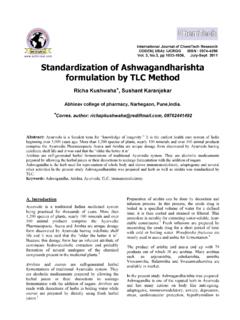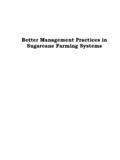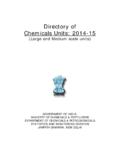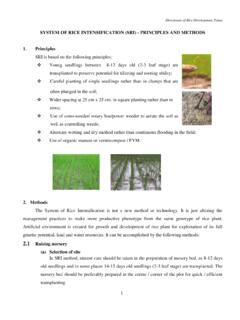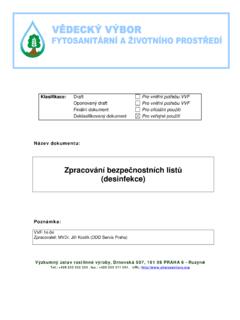Transcription of International Journal of ChemTech Research
1 Synthesis, Characterization and Pesticidal Potential of Metal Dimethyldithiocarbamates Anupma Arora1, and 1 Govt. Degree College, Kathua (J & K), India 2 Retired from Punjab Agricultural University, Ludhiana (Pb.), India Science College, Jammu (J & K), India Abstract : A series of transition metal dimethyldithiocarbamates have been synthesized and characterized on the basis of analytical and spectral data. The compounds have been screened for fungicidal potential and insecticidal potential and compared with the standard fungicides Indofil M-45 and Bavistin as well as with standard insecticide Carbaryl. Some of the synthesized complexes exhibited antifungal activity at par with standard fungicide, but none of the complexes could compete with standard insecticide.
2 Key Words : Organosulphur compounds, dithiocarbamates, fungicide, insecticide. Introduction Dithiocarbamates, an important class of Organosulphur compounds are well known for their vast chemical and biological properties1. And their activity is further enhanced when they are in the form of metal complexes. Metal dithiocarbamates are known to possess antibacterial2, antifungal3, 4 nematicidal5, insecticidal6 and antileishmanial7 properties. In view of the varied pesticidal properties of dithiocarbamates and in continuation of our earlier work, we have synthesized some metal dimethyldithiocarbamates, characterized and screened them for fungicidal and insecticidal properties. Experimental Synthesis & Characterization: Sodium dimethyldithiocarbamate was reacted with metal halide or sulphate in stoichiometric ratio in dichloromethane/water mixture.
3 The reaction was carried by stirring for different time intervals. The organic layer was separated, dried over anhydrous potassium sulphate and the complex was recovered by concentrating the solution8. Melting points were determined by capillary method and are uncorrected. Conductance was determined with Elico Conductivity Bridge of type CM82T fitted with platinized platinum electrodes. IR spectra (nujol) were recorded on Perkin Elmer Spectrophotometer. The solubility of various synthesized complexes was checked in different polar and non-polar solvents. Fungicidal Activity: The antifungal activity of the synthesized complexes was tested in vitro against three phytopathogenic fungi viz. Alternaria alternata, Fusarium oxysporum and Colletotrichum capsici using spore germination inhibition technique9, 10.
4 Parent metal salt was also taken and proceeded in the same way as the synthesized metal complex (Table 2). It was done to compare the activity of parent and synthesized compound. The stock International Journal of ChemTech Research CODEN (USA): IJCRGG, ISSN: 0974-4290, ISSN(Online):2455-9555 , pp 185-189, 2017 Anupma Arora et al / International Journal of ChemTech Research , 2017,10(9): 185-189. 186 solution/suspension (2000ppm) of the compound / parent salt wee prepared by dissolving 50mg of the compound in 2mL tetrahydrofuran (THF) and making the volume to 25 mL by adding distilled water. The stock solutions were serially diluted to obtain the required concentrations.
5 Cavity slides were used for studying the antifungal activity. The spore suspension of the test fungus (106 spores/mL) prepared in sterilized distilled water was mixed separately with the solution / suspension of the compound in the cavity slides. These slides were kept in Petri dishes lined with moist filter paper and incubated for 24 hours at 25 1 C. Untreated control was kept along with the treatments under same conditions. The germination of the spores was recorded and the per cent spore germination was calculated by following formula: Per cent Spore Spore germination in control Spore germination in treatment Germination Inhibition = _____ X 100 Spore germination in control The standard fungicides Indofil M-45 (75% manganese ethylene bis dithiocarbamate + 2% zinc) and Bavistin 50WP (methyl-2-benzimidazole carbamate) were used to compare the efficacy of the synthesized compounds.
6 The antifungal activity has been expressed in terms of ED50 values (effective dose to inhibit 50% spore germination) calculated by plotting the spore germination inhibition values against different concentrations of the compound on graph paper. The data were analyzed statistically. Insecticidal Activity: The insecticidal studies were conducted following CRD (completely randomized design) with three replications to evaluate the efficiency of laboratory prepared metal dimethyldithiocarbamates with standard insecticide carbaryl against the larvae of Spilosoma obliqua (Walker) on sunflower by leaf dip method. Laboratory reared fourth instar larvae were used for the experiment. Healthy leaves of sunflower brought from unsprayed field were dipped in solution/suspension of the metal complex of required concentration for one minute and were dried.
7 Ten Larvae of the test insect were released in each jar. Metal dimethyldithiocarbamates were tested at three different concentrations 300ppm, 500ppm, 1000ppm. These were compared with standard insecticide carbaryl. Untreated control was kept for comparison. The observations were recorded at 24 hours, 48 hours and 72 hours after treatment. At each observation, dead larvae were counted and removed from the jar. The corrected mortality was calculated on the basis of mortality in untreated control by modified Abbot s formula: Actual Mortality Mortality in Control Per cent Mortality = _____ X 100 100 Mortality in Control The data were statistically analyzed after suitable angular transformations. Results and Discussion Synthesis: The required metal dimethyldithiocarbamates were prepared by displacement reaction of metal sulphate (2a) or halide (2b) with sodium dimethyldithiocarbamate (1) in dichloromethane/water mixture according to the reported procedure (scheme 1).
8 The various synthesized complexes were almost soluble in benzene, tetrahydrofuran, chloroform and dichloromethane, whereas all were insoluble in petroleum ether, ethanol and water. The analytical results indicated 1:2 stoichiometry for 3b, 3d, 3e and 3f complexes and 1:3 stoichiometry for 3a and 3c complexes. All the complexes showed low conductance in dichloromethane indicating non-electrolytic nature. The ir spectra gave intense bands around 1458 cm-1, indicative of CN partial double bond of dithiocarbamate ligand11. Asymmetric C-S stretching vibration of metal dithiocarbamate complexes appeared in the 1000-965 cm-1 region12. Anupma Arora et al / International Journal of ChemTech Research , 2017,10(9): 185-189. 187 S The bands in the region 1260-1130 cm-1 have been assigned to NC< grouping13 (Table 1).
9 S CH2Cl2/H2O 6 [(CH3)2 NCS2-Na] + Cr2(SO4)3K2SO4 2[(CH3)2 NCS2]n M + 3 Na2SO4 1 2a 3a CH2Cl2/H2O n [(CH3)2 NCS2-Na] + MXn [(CH3)2 NCS2]n M + n NaX 1 2b 3b 3f n = 2; M = Mn, Ni, Cu, Zn n = 3; M = Cr, Fe 3a Cr 3b Mn 3c Fe 3d Ni 3e Cu 3f Zn Scheme 1 Table 1: Physical. Analytical and Spectral Data of Metal Dimethyldithiocarbamates S. No. Compound Molecular Formula Elemental Analysis % age Calculated (Observed) Specific Conductance (Sm-1) IR Bands (cm-1) M C N (CN) partial double bond (C-S) S (NC< ) S 1 Na DMDTC 136-1380C C3H6NS2Na - - - - 1430 950 - 3a Cr (DMDTC)3 130-1320C C9H18N3S6Cr ( ) ( ) ( ) X 10-3 1456 993 1141,1244,1256 3b Mn (DMDTC)2 140-1420C C6H12N2S4Mn ( ) ( ) ( ) X 10-3 1459 - 1133,1246,1260 3c Fe (DMDTC)3 >2600C C9H18N3S6Fe ( ) ( ) ( ) X 10-3 1462 966 1134,1244 3d Ni (DMDTC)2 117-1190C C6H12N2S4Ni ( ) ( ) ( ) X 10-3 1459 - 1138,1247,1262 3e Cu (DMDTC)2 >2600C C6H12N2S4Cu ( ) ( ) ( ) X 10-3 1457 975 1156,1253 3f Zn (DMDTC)2 138-1400C C6H12N2S4Zn ( ) ( ) ( )
10 X 10-3 1459 966 1151,1250 DMDTC = Dimethyldithiocarbamate Anupma Arora et al / International Journal of ChemTech Research , 2017,10(9): 185-189. 188 Table 2: Antifungal Potential of Metal Dimethyldithiocarbamates and their parent salts Metal Compound Denoted as ED50 Values (ppm) against A. alternata Na DMDTC 1 67 7 4 Cr2(SO4)3K2SO4 2a 30 12 70 Cr(DMDTC)3 3a 16 33 16 MnCl2 - 353 360 294 Mn(DMDTC)2 3b 28 34 13 FeCl3 - 17 16 7 Fe(DMDTC)3 3c 13 12 16 NiCl2 - 13 17 14 Ni(DMDTC)2 3d 17 34 16 CuCl2 - 6 5 7 Cu(DMDTC)2 3e 17 32 16 ZnCl2 - 16 29 15 Zn(DMDTC)2 3f 16 35 16 Indofil M-45 - 30 - 17 Bavistin - - 7 - DMDTC = Dimethyldithiocarbamate Fungicidal Activity: All the synthesized complexes were screened for their antifungal activity under in vitro conditions against three phytopathogenic fungi viz.



